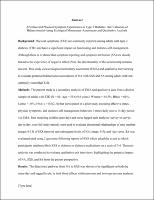Please use this identifier to cite or link to this item:
https://hdl.handle.net/20.500.12202/8329| Title: | Affective and Physical Symptom Experiences in Type 2 Diabetes: An Evaluation of Bidirectionality using Ecological Momentary Assessment and Qualitative Analysis |
| Authors: | Gonzalez, Jeffrey S Seng, Betsy Weinberger, Andrea Hillman, Bari Crandall, Jill Fishman, Sarah R. |
| Keywords: | Psychology Bidirectional Diabetes Negative affect Symptom Attribution Symptom Experience |
| Issue Date: | May-2022 |
| Publisher: | Yeshiva University |
| Citation: | Fishman, S. R. (2022, May). Affective and Physical Symptom Experiences in Type 2 Diabetes: An Evaluation of Bidirectionality using Ecological Momentary Assessment and Qualitative Analysis (Publication No. 29260406) [Doctoral dissertation, Yeshiva University]. ProQuest Dissertations & Theses Global |
| Series/Report no.: | Ferkauf Doctoral Dissertations;Publication Number: 29260406 |
| Abstract: | Abstract Background: Physical symptoms (SXS) are commonly reported among adults with type 2 diabetes (T2D) and have a significant impact on functioning and diabetes self-management. Although there is evidence that symptom reporting and symptom attribution (SA) are closely linked to the experience of negative affect (NA), the directionality of this relationship remains unclear. This study used ecological momentary assessment (EMA) and qualitative interviewing to evaluate potential bidirectional associations of NA with SXS and SA among adults with sub- optimally controlled T2D.¶ Methods: The present study is a secondary analysis of EMA and qualitative data from a diverse sample of adults with T2D (N = 61; Age = 55.6 (9.6 years); Women = 64.5%; Black = 61%; Latino = 36%; HbA1c = 8.6(2.3)) that participated in a pilot study assessing affective states, physical symptoms, and diabetes self-management behaviors 3-times daily over a 14-day period via EMA. Path modeling (within same day) and cross-lagged path analyses (survey to survey, day to day, over full study period) were used to evaluate directional relationships of total number (range: 0-13) of SXS reported and subsequent levels of NA (range: 0-5), and vice-versa. SA was evaluated used using 2 questions following reports of SXS which asked the extent to which participants attributed their SXS to diabetes or diabetes medications on a scale of 0-4. Thematic analysis was conducted to evaluate qualitative exit interviews, highlighting the potential impact of NA, SXS, and SA from the patient perspective.¶ Results: The directional pathway from NA to SXS was shown to be significant on both the same-day and lagged levels, in both fixed effects within-persons and between-persons analyses. Same-day analyses demonstrated that, on a within-persons level, a 1-point increase in NA from one’s personal mean was associated with a 0.42-point increase in subsequent physical symptom experience within the same day (95% CI: 0.25-0.59, p <.01). Cross-lagged path analysis demonstrated a 1-point increase in NA from one’s personal mean was associated with a 0.14- point increase in subsequent symptom experience (95% CI: 0.03 - 0.25, p <.01). Similar trends were found on the between-persons level. The directional pathway from SXS to NA was shown to be significant for both same-day within-person fixed effects, and between-person fixed effects levels. Same-day analyses demonstrated that, on a within-persons level, a 1-point increase in SXS from one’s personal mean was associated with a 0.12-point increase in subsequent NA within the same day (95% CI: 0.08 - 0.17, p <.01); on a between-persons level, a 1-point increase in SXS from one’s personal mean was associated with a 0.52-point increase in subsequent NA within the same day (95% CI: 0.31 - 0.69, p <.01). Day-level results indicate bidirectionality, with pathway significance identified in both the NA to SXS and SXS to NA directions. The NA to symptom attribution to T2D pathway was found to be significant as a 1-point increase in NA from one’s personal mean was associated with a 0.16-point increase in attribution score (95%CI: 0.01 - 0.32, p <.01) between-persons. Moderation analyses demonstrated that symptom attribution did not significantly moderate the relationship between symptom experience and NA, such that attributing symptoms to diabetes and/or diabetes medication was not predictive of a significant increase in NA. Qualitative analysis supported similar patterns to those observed in quantitative findings with participants reporting impactful connection between NA and SXS, though direct illustration of the bidirectional relationship between symptom experience and affect could not be concluded. ¶ Discussion: Results showed a bidirectional pathway between NA and SXS, on the day-level, with the NA to SXS pathway further supported in cross-lagged analyses. Pathways illustrated that an increase in NA was related to an increase in SXS as next time point both overtime and within same day. The reverse relationship was seen within same day, but not overtime. The salience of the relationships between NA and SXS was also observed through qualitative analysis of exit interviews with participants. These findings from predominantly ethnic minority adults with T2D largely supported hypotheses. If these associations are causal, these results suggest that interventions that reduce negative affect would also reduce the experience of physical symptoms and vice versa. Given prior evidence linking these NA and SXS to self- management, functioning, and health outcomes in T2D, such interventions could have a substantial impact. The current study’s findings contribute to the literature supporting relationships among NA, SXS, and SA and also demonstrate the necessity for future research to understand the complexities of influence among the examined variables to inform future intervention design. |
| Description: | Doctoral dissertation, PhD / Open Access |
| URI: | https://hdl.handle.net/20.500.12202/8329 https://ezproxy.yu.edu/login?url=https://www.proquest.com/dissertations-theses/affective-physical-symptom-experiences-type-2/docview/2697660655/se-2?accountid=15178 |
| ISBN: | 9798837528095 |
| Appears in Collections: | Ferkauf Graduate School of Psychology: Doctoral Dissertations |
Files in This Item:
| File | Description | Size | Format | |
|---|---|---|---|---|
| Fishman_Dissertation_5.27.2022 OA Affective and Physical.pdf | 1.01 MB | Adobe PDF |  View/Open |
This item is licensed under a Creative Commons License

